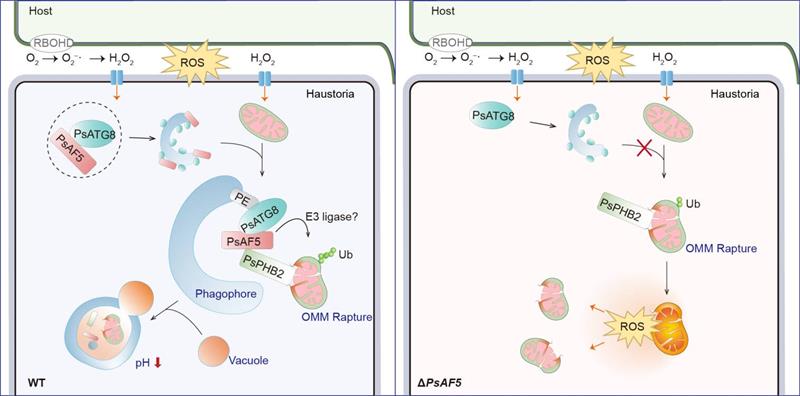Recently, research team from our college has just published a paper online which titled "PsAF5 functions as an essential adapter for PsPHB2-mediated mitophagy under ROS stress in Phytophthora sojae" in the journal Nature Communications. The study discovered that the protein PsAF5, containing ANK and FYVE domains, serves as a ligand for the mitochondrial inner membrane autophagy receptor PsPHB2, participating in the regulation of mitochondrial autophagy mechanism in response to reactive oxygen species (ROS) in Phytophthora sojae by influencing the interaction between PsPHB2 and PsATG8. A graduated student from our college, Dr. Li Wenhao, and the PhD students, Zhu Hongwei and Chen Jinzhu, are the co-first authors of this paper. Associate Researcher Miao Jianqiang and Prof. Liu Xili are the co-corresponding authors of the paper.

Reactive oxygen species (ROS) generated in the apoplast of host plants in response to pathogen infection is an important defensive reaction of the plant innate immune system. As the metabolic center of cellular substances and energy, mitochondria are not only the main source of intracellular ROS but also the main target of ROS damage. Currently, how pathogenic effector proteins inhibit the production of host ROS has been widely studied. However, the question of how plant pathogenic oomycetes increase ROS tolerance and maintain mitochondrial homeostasis during infection remains unclear.
In this study, through bioinformatics analysis, the researchers found that there were 10 AFs genes containing both ANK and FYVE domains in Phytophthora sojae. It was found that the PsAF5 knockout transformants exhibited increased sensitivity to H2O2 and significantly reduced pathogenicity, suggesting that PsAF5 is an important factor for Phytophthora sojae to respond to ROS stress. Further studies revealed that the interaction and co-localization between PsAF5 and PsATG8 were enhanced under ROS treatment, and the knockout of PsAF5 prevented mitochondrial autophagy under conditions of ROS treatment and mitochondrial autophagy inducer treatment. Protein interaction and serial validation experiments demonstrated that PsAF5 interacts with the mitochondrial inner membrane protein PsPHB2 through the ANK domain and is recruited to damaged mitochondria. Moreover, the exposure of PsPHB2 caused by mitochondrial damage under ROS stress is a necessary condition for its interaction with PsAF5. In summary, PsAF5 serves as a "bridge" for the interaction between PsATG8 and PsPHB2, recruiting PsATG8 to damaged mitochondria under ROS stress and initiating the mitochondrial autophagy pathway.
This is the first study to discover a new ligand protein, PsAF5, which plays a "bridge" role in recruiting PsATG8 by PsPHB2. Since AFs proteins exist in different eukaryotes, the authors speculate that the PHB2-AF5-ATG8 protein complex and its functional mode may be conserved in other eukaryotes. The research results enrich our understanding of receptor-mediated mitochondrial autophagy in eukaryotes and provide a theoretical basis for the discovery of novel drug molecular targets.

The role of PsAF5 as a "ligand" in ROS-induced mitochondrial autophagy
This research work was funded by the National Natural Science Foundation of China and the Shaanxi Provincial Science and Technology Innovation Team and other projects. The experimental platform of the State Key laboratory for Crop Stress Resistance and High-Efficiency Production provided technical support for the completion of the research work.
Original link: https://www.nature.com/articles/s41467-024-46290-z